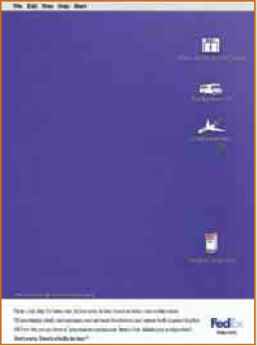The Internet Powerful IMC Tool or Just Another Medium
The rise and fall of the World Wide Web (WWW) brings to mind images of riding a roller-coaster. First there was the very rapid growth of the medium and the dot-com boom. Next came the

dot-com bust and rapid downhill spending by marketers. Now the predictions are that the Net is slowly climbing back up. It appears that the ups and downs of this medium have many marketers confused about how to use the Internet.
Part of the problem regarding how best to use the Internet can be attributed to the infancy of this medium and to differing opinions as to what role the Internet should assume. Direct marketers, for example, argue that the Internet is just another direct-marketing medium—albeit one with great sales potential. Others take a much broader perspective, viewing the Internet as an important IMC tool capable of supporting and enhancing other program elements. They see the Internet as a medium whose role is central to the effectiveness of the IMC program.
One of the proponents of the latter perspective is David A. Aaker, a University of CaliforniaBerkeley professor and the author of numerous articles and books on branding. Aaker argues that one of the ways to improve the ROI of brand marketing is to "increase the synergies and impact among the firm's individual brand-building programs so that the whole is greater than the sum of its parts." Aaker's view of the Internet is not that it is just another medium but that it is the "integrator" of the IMC program—the "glue" that holds the IMC program together. Proper integration of the Internet into the IMC program, he argues, requires that it is used creatively and as a component of the overall brand-building process. He feels that the Internet can be used to amplify other IMC elements.
One of the problems with the Internet, however, has been the inability of marketers to implement what Aaker has suggested. For years, companies have struggled with how to use the Net for branding purposes. The literature is full of articles on this problem, and many are of the notion that marketers aren't quite there yet. They cite the fact that there are not many powerful success stories to support the branding efforts.
At the same time, there are numerous examples of Internet success stories that go beyond direct marketing and support the position of proponents of a more enhanced role for the medium. Aaker cites numerous examples of effective branding and integration programs involving PepsiCo, Oscar Mayer, Valvoline, FedEx, and Procter & Gamble among others. Since it declared bankruptcy in 2002, Kmart has also relied more heavily on the Net to reclaim its brand image, emphasizing tighter cross-integration of IMC components through its "Stuff of Life" campaign. Its website now carries exactly the same logo, type fonts, and imagery as every other component, including TV and print.
While the above list reflects the success experienced by large companies with large communications budgets, one shouldn't be deceived into thinking that integration is the domain of only those with large expenditure capabilities. The issue is not so much the amount of money spent but how it is spent, and there are plenty of success stories among smaller companies with less money but good strategies. Crate & Barrel, Godiva, and Sharper Image are just a few of the companies that have enhanced their brands through effective merchandising on the Web while still maintaining the selling component. Territory Ahead, akademiks, and fubu have created strong brand images among their target audiences with limited budgets and a strong Internet premise.
The capability of the Internet to tie together various elements of the IMC program may take the medium back to the top again. Let's just hope that its lack of integration doesn't take it back down.
Sources: David A. Aaker, "Fast Brand Building in Slow-Growth Markets," strategy+business, Third Quarter 2002, pp. 48-57; Mary Wagner, "Richard Blunck Has Kmart.com Ready for Success—the Rest Is Up to Kmart," Internet Retailer, September 2002, pp. 18-21; Mary Wagner, "On the Web, Merchandising No Longer Follows Rules Developed in Other Channels," Internet Retailer, September 2002, pp. 22-25.
Anyone who has followed the Internet industry over the last decade has seen an amazing series of events. Moving from a medium with almost no presence in the marketing environment to one that was the center of attention, the Internet experienced a boom that unfortunately became a bust. What some marketers thought would be the "be all and end all" of communications has now become a puzzle waiting to be solved, as many marketers have yet to discover what role the Internet will assume in their communications program.
What the lead-in to this chapter illustrates, however, is that some companies have apparently solved the puzzle and have effectively integrated the Internet into their marketing communications programs. As you will see in this chapter, others have been successful as well, particularly when they view the Internet as a component of the integrated marketing communications program and not as the only tool required for success.
In this chapter we will discuss the Internet and interactive media, marketers' objectives for using these media, and ways to measure their effectiveness. As you will see, the Internet and interactive media are valuable components of the integrated marketing communications program and, like other components, are most effective when used in conjunction with other program elements. We will begin our discussion with the Internet.
Before beginning our discussion, it may be useful to establish some common ground. While all of us are familiar with the Internet, the degree to which we are familiar varies. Understanding the material presented in this chapter will be easier if you are familiar with the terms used in the discussion.
The Internet is a worldwide means of exchanging information and communicating through a series of interconnected computers. It was started as a U.S. Defense Department project, but it is now accessible to anyone with a computer and a modem. While the most popular component of the Internet is the World Wide Web (WWW), there are other features as well, as shown in Figure 15-1. For marketers, a number of these features offer potential, but it is the Web that has developed as the commercial component. For that reason, the following discussion will focus on using the Web as a communications and sales tool. Before reading further, however, please take a few minutes to examine Figure 15-2, to familiarize yourself with some of the terms that we will be using. In reality, there are many more words that have been added to our language as a result of the growth of the Internet (you can actually purchase a dictionary of Internet terms), but space permits only a small inclusion here. Thus, we have stayed away from the technical jargon, concentrating primarily on marketing communications terms. If you are not familiar with terms like URL, backbone, browser, and so on, you may wish 486 to consult another source before continuing.
|
Feature |
Use |
Continue reading here: Developing and Maintaining a Website
Was this article helpful?
Readers' Questions
-
jarno1 year ago
- Reply

